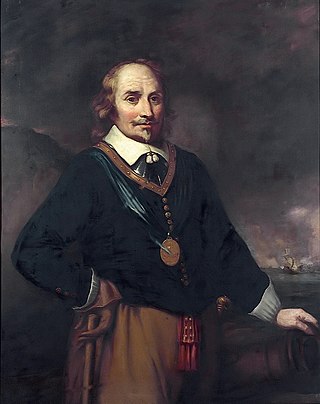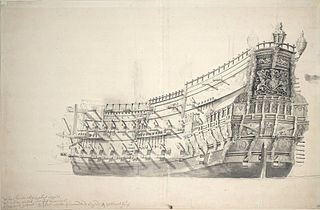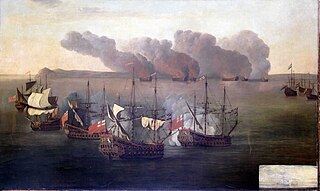
Maarten Harpertszoon Tromp or Maarten van Tromp was an army general and admiral in the Dutch navy during much of the Eighty Years' War and throughout the First Anglo-Dutch War. Son of a ship's captain, Tromp spent much of his childhood at sea, during which time he was captured by pirates and enslaved by Barbary corsairs. In adult life, he became a renowned ship captain and naval commander, successfully leading Dutch forces fighting for independence in the Eighty Years' War, and then against England in the First Anglo-Dutch War, proving an innovative tactician and enabling the newly independent Dutch nation to become a major sea power. He was killed in battle by a sharpshooter from an English ship. Several ships of the Royal Netherlands Navy have carried the name HNLMS Tromp after him and/or his son Cornelis, also a Dutch admiral of some renown.

The Battle of the Gabbard, was a naval battle fought from 2 to 3 June 1653 during the First Anglo-Dutch War. It took place near the Gabbard shoal off the coast of Suffolk, England, between fleets of the Commonwealth of England and the Dutch Republic. It resulted in a significant English victory.

Robert Blake was an English naval officer who served as general at sea and the Lord Warden of the Cinque Ports from 1656 to 1657. Blake served under Oliver Cromwell during the English Civil War and Anglo-Spanish War, and as the commanding Admiral of the State's Navy during the First Anglo-Dutch War. Blake is recognized as the "chief founder of England's naval supremacy", a dominance subsequently inherited by the British Royal Navy well into the early 20th century. Despite this, due to deliberate attempts to expunge the Parliamentarians from historical records following the Stuart Restoration, Blake's achievements tend to remain relatively unrecognized. Blake's successes, however, are considered to have "never been excelled, not even by Nelson" according to one biographer, while Blake is often compared with Nelson by others.

Sovereign of the Seas was a 17th-century warship of the English Navy. She was ordered as a 90-gun first-rate ship of the line, but at launch was armed with 102 bronze guns at the insistence of the king. She was later renamed Sovereign under the republican Commonwealth, and then HMS Royal Sovereign at the Restoration of Charles II.

Royal Charles was an 80-gun first-rate three-decker ship of the line of the English Navy. She was built by Peter Pett and launched at Woolwich Dockyard in 1655, for the navy of the Commonwealth of England. She was originally called Naseby, named in honour of Sir Thomas Fairfax's decisive 1645 victory over the Royalist forces during the English Civil Wars. She was ordered in 1654 as one of a programme of four second rates, intended to carry 60 guns each. However, she was altered during construction to mount a complete battery of guns along the upper deck, and so was reclassed as a first rate.

HMS La Hogue was a 74-gun third-rate ship of the line of the Royal Navy, launched on 3 October 1811 at Deptford. She was named after the 1692 Battle of La Hogue. "The La Hogue of 1811 [...] sported a green and chocolate lion, its grinning mouth displaying rows of white teeth and a huge red tongue."

HMS Africa was a 64-gun third-rate ship of the line of the Royal Navy, launched by William Barnard at Barnard's Thames Yard in Deptford on 11 April 1781.

HMS Duke was a 90-gun second-rate ship of the line of the Royal Navy, launched on 13 June 1682 at Woolwich Dockyard.

HMS Warspite was a 70-gun third-rate ship of the line of the Royal Navy, launched in 1666 at Blackwall Yard. This second Warspite was one of the five ships designed to carry more provisions and lower deck guns higher above the water than French and Dutch equivalents. In 1665 the Second Anglo-Dutch War had begun and on 25 July 1666 Warspite was one of 23 new English warships helping to beat a Dutch fleet off North Foreland, Kent. She won again distinction on Christmas Day 1666 as senior officer's ship out of five sent to protect an important convoy of naval stores from the Baltic. Warspite next took part in the first action of the Third Anglo-Dutch War on 28 May 1672 off Southwold Bay, Suffolk. This desperate 14-hour battle, generally known as Solebay, was a drawn fight; but Warspite successfully fended off a pair of Dutch fire ships exactly as she had done off North Foreland. By 1685, she was mounting only 68 guns.
HMS Ruby was a 40-gun frigate of the Commonwealth of England, built by Peter Pett at Deptford. She took part in actions during all three of the Anglo-Dutch Wars of 1652–1654, 1665–1667 and 1672–1674. She later served in the West Indies, and in 1683 was sent to the Leeward Islands to protect British settlements against Caribbean pirate raids. In 1687, the English pirate Joseph Bannister was captured by the crew of Ruby and brought to Port Royal for trial. She was rebuilt in 1687. She was captured by the French in October 1707.

HMS Rodney was a two-deck 90-gun second-rate ship of the line of the Royal Navy. Launched in 1833, she was broken up in 1884.

The Prince Royal was a 55-gun royal ship of the English Royal Navy. It was later rebuilt and renamed HMS Resolution.

Constant Reformation was a 42-gun great ship of the English navy, built by William Burrell at Deptford and launched in 1619. It first saw action in the English expedition to Algiers (1620–1621), then in the unsuccessful Cádiz expedition (1625), part of the Anglo-Spanish War (1625–1630).

Victory was a great ship of the English Navy, launched in 1620 and in active service during the seventeenth century's Anglo-Dutch Wars. After a seventy-year naval career, she was broken up at Woolwich Dockyard in 1691 and her timbers reused in other vessels.

The frigate Gloucester was a Speaker-class third rate, commissioned into the Royal Navy as HMS Gloucester after the restoration of the English monarchy in 1660. The ship was ordered in December 1652, built at Limehouse in East London, and launched in 1654. The warship was conveying James Stuart, Duke of York to Scotland, when on 6 May 1682 she struck a sandbank off the Norfolk coast, and quickly sank. The Duke was among those saved, but as many as 250 people drowned, including members of the royal party; it is thought that James's intransigence delayed the evacuation of the passengers and crew.
Sapphire was a 38-gun fourth-rate of the Commonwealth of England. After commissioning she was actively involved in the First Anglo-Dutch War, participating in most major fleet actions. During the Second Anglo-Dutch War, she was only in the first two engagements then spent her time in Irish Waters and the Mediterranean. She was run ashore due to a pending attack by suspected Algerian pirates on Sicily in March 1670.

HMS Centurion was one of six 40-gun fourth-rate frigates, built for the Commonwealth of England under the 1650 Programme, she would be transferred to the navy of the Kingdom of England upon the Restoration of the monarchy in May 1660. When commissioned she partook in the First Anglo-Dutch War. After the first war ended she was in the Mediterranean fighting the Algerines at the Battle of Santa Cruz. She fought the battles of Dover, Portland, the Gabbard, and Scheveningen. During the Second Anglo-Dutch War she partook in the battles of Lowestoft and Orfordness. Following the second war she spent her time either in North America or the Mediterranean. She was wrecked in a storm in December 1689.
HMS Assistance was one of six 40-gun fourth-rate frigates, built for the Commonwealth of England under the 1650 Programme, after the Restoration of the monarchy in 1660 she was incorporated into the navy of the Kingdom of England. During her time in the Commonwealth Navy she partook in the First Anglo-Dutch War being present in the battles of Kentish Knock, Portland and The Gabbard. In the Mediterranean she was present at the Battle of Santa Cruz and the bombardment of Porto Farina, In the Second Anglo-Dutch War she was involved in the Battle of Lowestoft, Battle of Vagen and the St James Day Fight. She did not participate in fleet actions after this. She spent the rest of her service life undergoing several rebuilds and plying the waters as a cruiser protecting British trade and projecting British sovereignty. After nearly 95 years of Service she was sunk as a break water at Sheerness at the end of 1745.

The Battle of Santa Cruz de Tenerife was a military operation in the Anglo-Spanish War (1654–60) which took place on 20 April 1657. An English fleet under Admiral Robert Blake penetrated the heavily defended harbour at Santa Cruz de Tenerife in the Spanish Canary Islands and attacked their treasure fleet. The treasure had already been landed and was safe but the English engaged the harbour forts and the Spanish ships, many of which were scuttled and the remainder burnt. Having achieved his aim, Blake withdrew without losing any ships.

HMS Victory is a 104-gun first-rate wooden sailing ship of the line. With 246 years of service as of 2024, she is the world's oldest naval vessel still in commission. She was ordered for the Royal Navy in 1758, during the Seven Years' War and laid down in 1759. That year saw British victories at Quebec, Minden, Lagos and Quiberon Bay and these may have influenced the choice of name when it was selected in October the following year. In particular, the action in Quiberon Bay had a profound affect on the course of the war; severely weakening the French Navy and shifting its focus away from the sea. There was therefore no urgency to complete the ship and the signing of the Treaty of Paris in February 1763, meant that when Victory was finally floated out in 1765, she was placed in ordinary. Her construction had taken 6,000 trees, 90% of them oak.


















